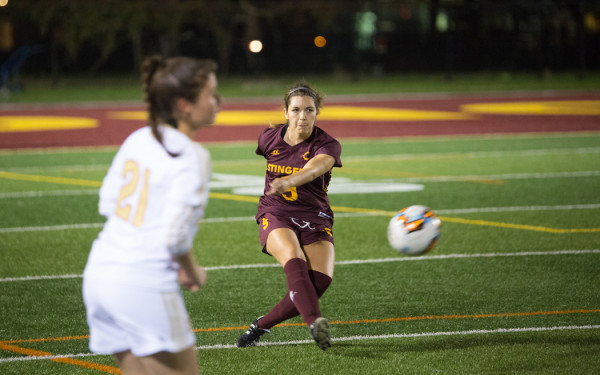Stingers Women’s Soccer Add Sports Science
Women’s Soccer Team To Use Sports Science In Pilot Project
At the end of practice, ten players from the Concordia Stingers women’s soccer team retreat to the rafters and lift their shirts halfway up to unclip a red strap wrapped around their lower chest. This little strap represents the first step in an effort to shift the way the team will train.
As part of a pilot project, the women’s soccer team began a process to bring sports science to the Stingers for training and in-game situations. With this goal in mind, the athletics department purchased ten chips made by the company Polar for the team to use in practice and during games.
The new technology is a little chip attached to a strap tied over the heart. The chip calculates the player’s heart rate, kilometres ran, the number of sprints made and running accuracy through a heat map. All of this data goes from the chip to a satellite and right back to the coaching staff’s iPad in real time.
This kind of technology was first introduced through the men’s soccer team and its head coach Greg Sutton, but it only monitored heart rates.
It was due to budgetary reasons that the women’s team didn’t get similar technology as the men, according to Concordia Athletics Director Patrick Boivin.
When the women’s soccer coach Jorge Sanchez first saw this, he wanted in on the project—except with bigger plans.
“When Greg presented to all the coaches that he’d bought this and I said: ‘Well, I’d like to take it one step further and I want to get the GPS chip,’” Sanchez said.
After financial negotiations between Boivin and the coaching staff, funds were cleared to buy ten chips.
“[Boivin] said, I’m open to initiatives that have value added,” said Sanchez. “It’s a good investment but we were able to find the funds and now it’s up to us to show that the money’s well spent.”
For Frederique Labelle, a masters student in exercise science and the assistant coach in charge of the project, the new technology is a benefit for players who played as well as the ones who remained on the bench.
“For the girls, seeing where they actually ran on the field is pretty cool,” Labelle said. “Let’s say someone didn’t play the first game. They can look at the heat map of the player that was playing at their position and see what’s expected of them.”
Having played with the team last season, Labelle has a unique position towards using the team’s new setup with former teammates.
“I was in their position last year,” said Labelle. “So for me to get to see what our body is actually doing, three times a week at practice, two times a week at games, and then to see the distance covered and the sprint made is really cool.”
Having only used the technology in preseason training, three exhibition games and Saturday’s season opener against the McGill Martlets, the product is still brand new for the coaching staff. Despite not analyzing the data yet, Sanchez and Labelle have begun formulating their plan.
“They can’t hide. It really is Big Brother.” – Head Coach Jorge Sanchez
“The idea is that Fred created a fixed schedule, the players come see her, and we’re going to create a database of players,” said Sanchez. “We can see in the metrics, if they’re wearing it, their activity and what they thought they did well and the parts that they didn’t do well.”
For Sanchez and Boivin, the technology creates a professional enviroment for players. Knowing that they are the only team in the department to have such a thing makes them take it more seriously.
“For me that’s the value added. The players go: ‘Wow the Stingers are all getting this?’ No we’re the only team,” said Sanchez. “‘Oh, you mean men’s and women’s soccer?’ No, only women’s soccer is getting this. And they go ‘Wow that’s cool.’”
It also gives Sanchez and his staff a new way of giving feedback to his team. They don’t always have to rely on opinion-based judgment when debriefing a player’s performance.
“Players that say they ran so much in this game, well actually not really, you only ran five kilometres and the person right beside you ran ten,” said Sanchez. “It’s not us making an opinion based judgment, it’s us actually using sports science to give feedback.”
“They can’t hide. It really is Big Brother.”
During her visit at Stingers training last week, Canadian national soccer team player and Olympic medalist Rhian Wilkinson told the team about her relationship with sports
science.
“She was wearing a Polar watch and she mentioned that every Wednesday in her training period she has to connect her watch to a computer to the central server of her weekly training,” said Sanchez.
If the pilot project has positive reviews, the addition of smart watches is something Sanchez would be interested in. During the offseason where Sanchez tells his players to run five
kilometres regularly, instead of having players email him every time, he would log in to a website and see his players’ progression.
As for expansion of sports science to other programs, Boivin is open to the possibility should the coaches show interest. He agrees that the technology would lend itself well to the
hockey and basketball programs but he will not force them to do it.
“It is a more coach-based decision. How do they want to track and analyze their athletes’ performance and progression in their training and [during games]?” said Boivin. “You can’t go against the way that a coach wants to develop its players.”

2WEB_900_600_90.jpg)
_600_832_s.png)

1_600_375_90_s_c1.jpg)
1_600_375_90_s_c1.jpg)

4_600_375_90_s_c1.jpg)